A Deep Dive into Corporation and Contract Law: The Corporate Veil
VerifiedAdded on 2023/04/04
|11
|2793
|332
Essay
AI Summary
This essay provides a detailed analysis of the corporate veil theory in corporation and contract law, exploring the concept of a company as a separate legal entity and the implications of this separation. It discusses situations where the corporate veil can be lifted or pierced, such as to determine the corporation's characteristics, protect taxes and revenues, prevent the evasion of legal obligations, address fraud or improper conduct, or when a subsidiary acts as an agent. The essay also examines the alter-ego and instrumentality theories used to justify lifting the corporate veil. Landmark cases like Salomon v. A Salomon & Co. Ltd., Lee v. Lee’s Air Farming Ltd., and The King v Portus; ex parte Federated Clerks Union of Australia are referenced to illustrate the application of these principles in legal practice. The essay concludes by emphasizing that while the corporate veil provides limited liability to shareholders, it is subject to exceptions where the veil can be lifted to reveal the individuals behind the corporation.
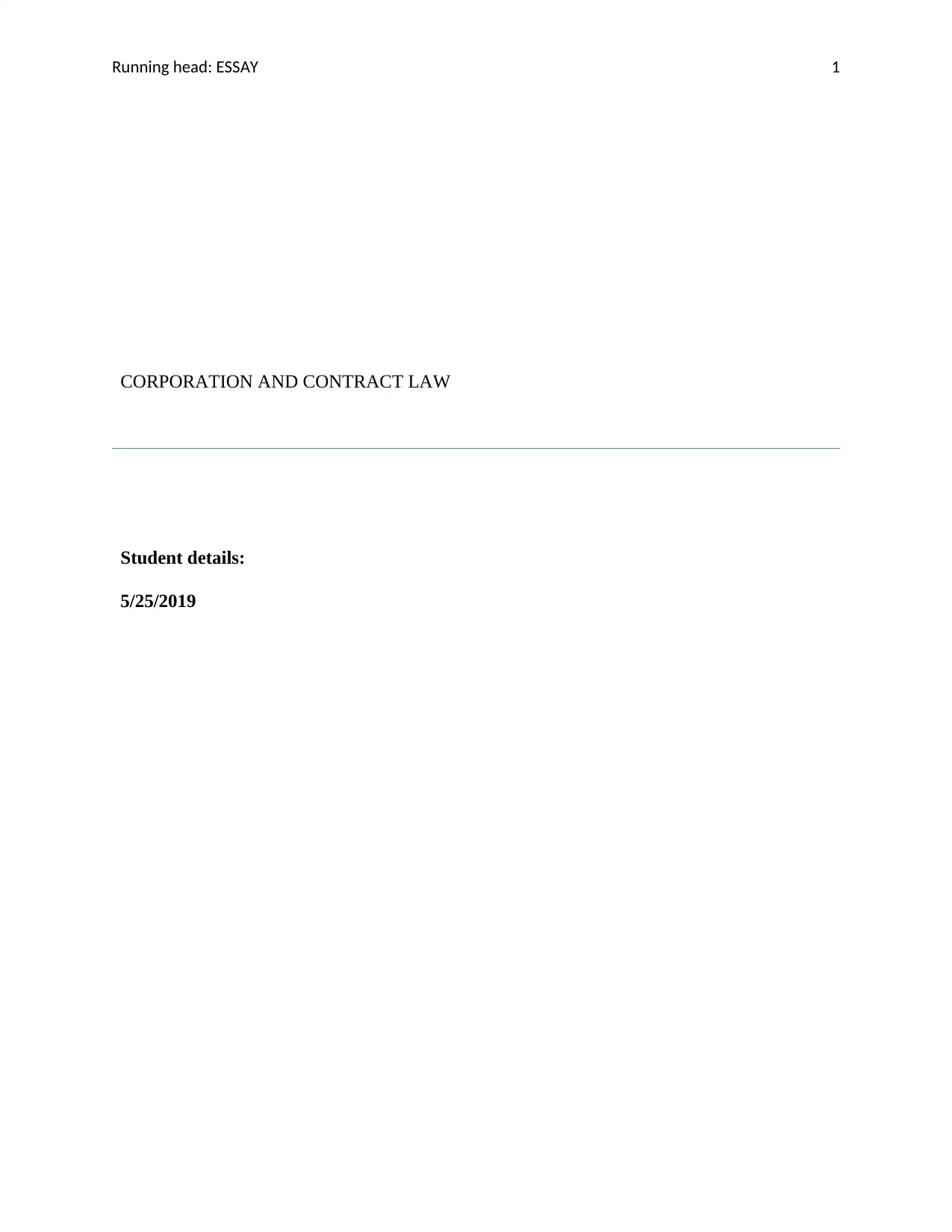
Running head: ESSAY 1
CORPORATION AND CONTRACT LAW
Student details:
5/25/2019
CORPORATION AND CONTRACT LAW
Student details:
5/25/2019
Paraphrase This Document
Need a fresh take? Get an instant paraphrase of this document with our AI Paraphraser
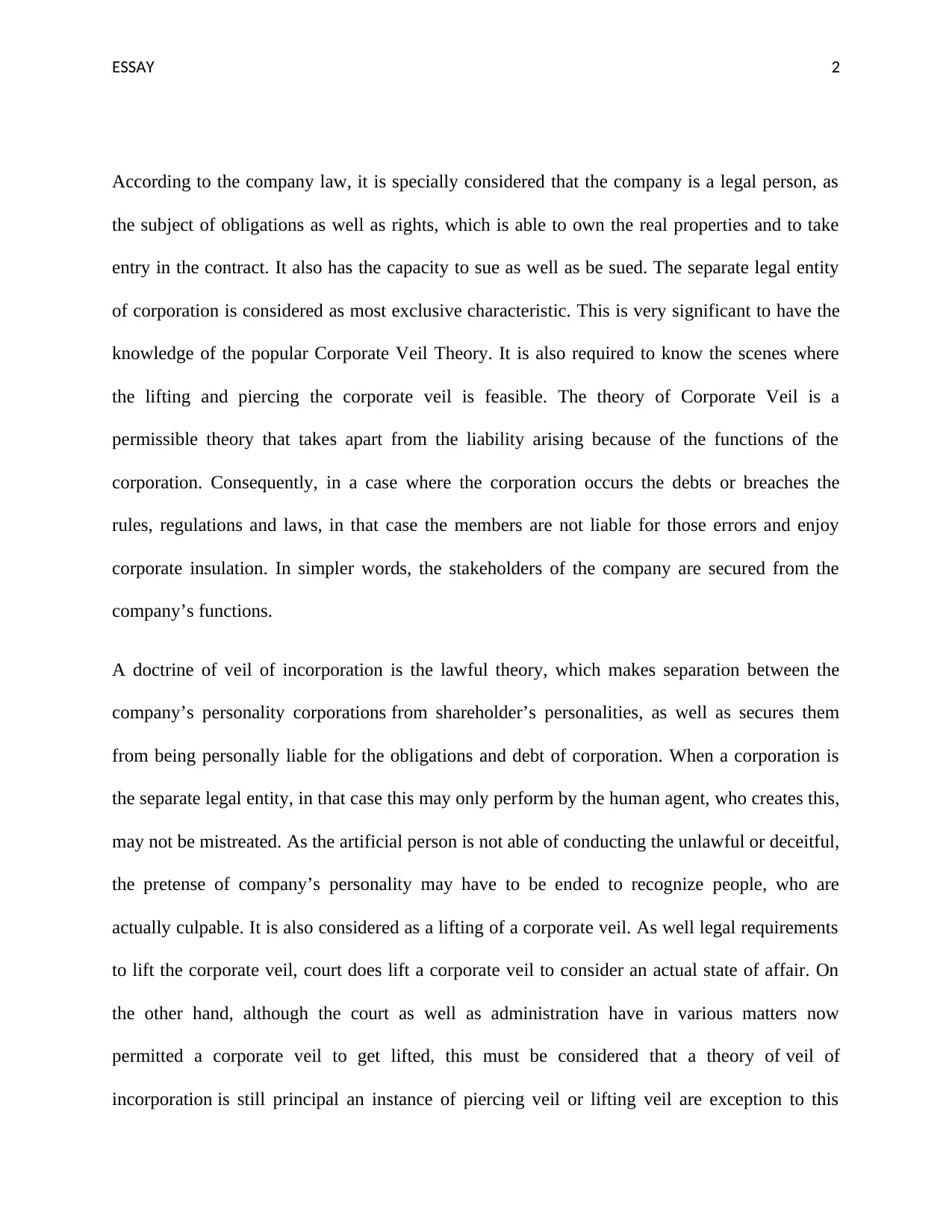
ESSAY 2
According to the company law, it is specially considered that the company is a legal person, as
the subject of obligations as well as rights, which is able to own the real properties and to take
entry in the contract. It also has the capacity to sue as well as be sued. The separate legal entity
of corporation is considered as most exclusive characteristic. This is very significant to have the
knowledge of the popular Corporate Veil Theory. It is also required to know the scenes where
the lifting and piercing the corporate veil is feasible. The theory of Corporate Veil is a
permissible theory that takes apart from the liability arising because of the functions of the
corporation. Consequently, in a case where the corporation occurs the debts or breaches the
rules, regulations and laws, in that case the members are not liable for those errors and enjoy
corporate insulation. In simpler words, the stakeholders of the company are secured from the
company’s functions.
A doctrine of veil of incorporation is the lawful theory, which makes separation between the
company’s personality corporations from shareholder’s personalities, as well as secures them
from being personally liable for the obligations and debt of corporation. When a corporation is
the separate legal entity, in that case this may only perform by the human agent, who creates this,
may not be mistreated. As the artificial person is not able of conducting the unlawful or deceitful,
the pretense of company’s personality may have to be ended to recognize people, who are
actually culpable. It is also considered as a lifting of a corporate veil. As well legal requirements
to lift the corporate veil, court does lift a corporate veil to consider an actual state of affair. On
the other hand, although the court as well as administration have in various matters now
permitted a corporate veil to get lifted, this must be considered that a theory of veil of
incorporation is still principal an instance of piercing veil or lifting veil are exception to this
According to the company law, it is specially considered that the company is a legal person, as
the subject of obligations as well as rights, which is able to own the real properties and to take
entry in the contract. It also has the capacity to sue as well as be sued. The separate legal entity
of corporation is considered as most exclusive characteristic. This is very significant to have the
knowledge of the popular Corporate Veil Theory. It is also required to know the scenes where
the lifting and piercing the corporate veil is feasible. The theory of Corporate Veil is a
permissible theory that takes apart from the liability arising because of the functions of the
corporation. Consequently, in a case where the corporation occurs the debts or breaches the
rules, regulations and laws, in that case the members are not liable for those errors and enjoy
corporate insulation. In simpler words, the stakeholders of the company are secured from the
company’s functions.
A doctrine of veil of incorporation is the lawful theory, which makes separation between the
company’s personality corporations from shareholder’s personalities, as well as secures them
from being personally liable for the obligations and debt of corporation. When a corporation is
the separate legal entity, in that case this may only perform by the human agent, who creates this,
may not be mistreated. As the artificial person is not able of conducting the unlawful or deceitful,
the pretense of company’s personality may have to be ended to recognize people, who are
actually culpable. It is also considered as a lifting of a corporate veil. As well legal requirements
to lift the corporate veil, court does lift a corporate veil to consider an actual state of affair. On
the other hand, although the court as well as administration have in various matters now
permitted a corporate veil to get lifted, this must be considered that a theory of veil of
incorporation is still principal an instance of piercing veil or lifting veil are exception to this
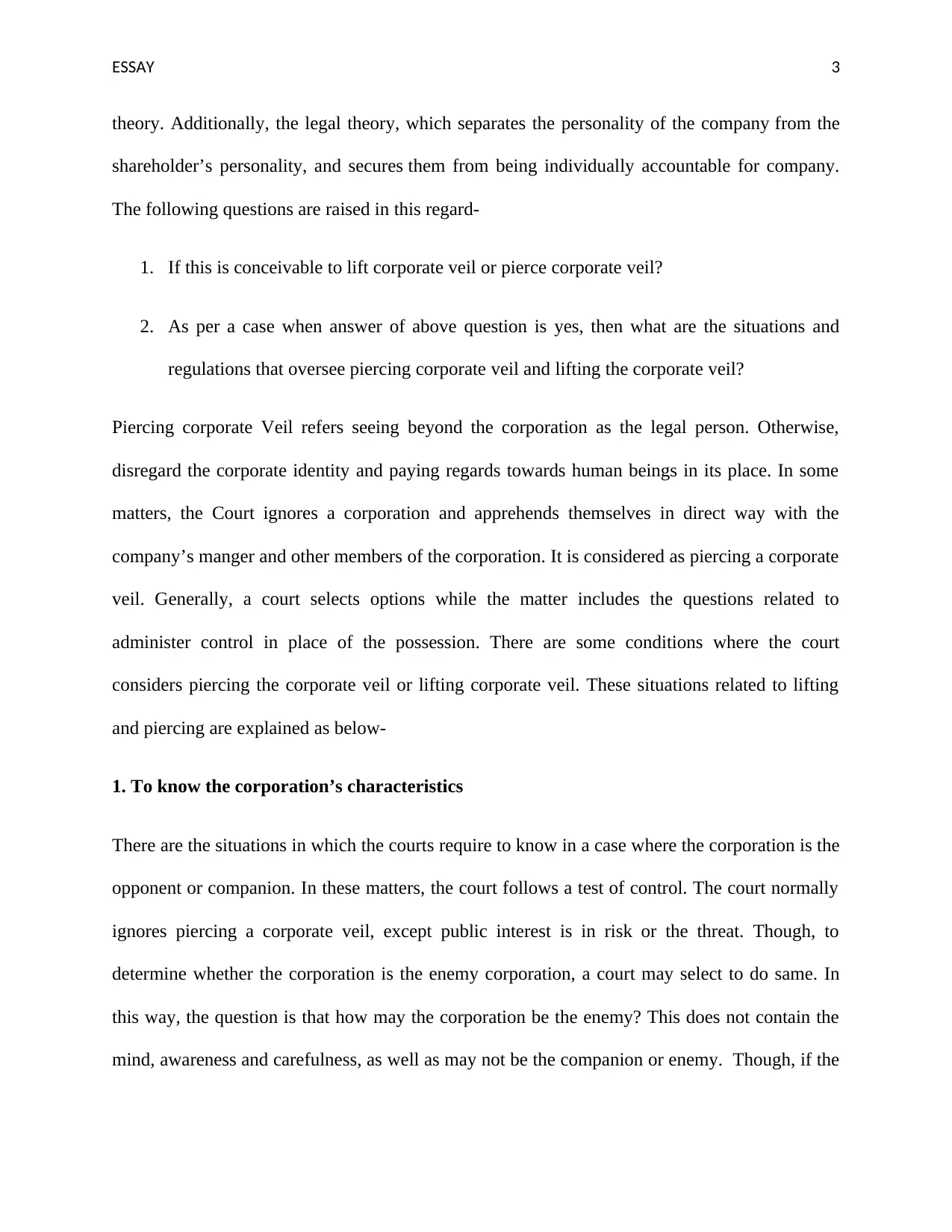
ESSAY 3
theory. Additionally, the legal theory, which separates the personality of the company from the
shareholder’s personality, and secures them from being individually accountable for company.
The following questions are raised in this regard-
1. If this is conceivable to lift corporate veil or pierce corporate veil?
2. As per a case when answer of above question is yes, then what are the situations and
regulations that oversee piercing corporate veil and lifting the corporate veil?
Piercing corporate Veil refers seeing beyond the corporation as the legal person. Otherwise,
disregard the corporate identity and paying regards towards human beings in its place. In some
matters, the Court ignores a corporation and apprehends themselves in direct way with the
company’s manger and other members of the corporation. It is considered as piercing a corporate
veil. Generally, a court selects options while the matter includes the questions related to
administer control in place of the possession. There are some conditions where the court
considers piercing the corporate veil or lifting corporate veil. These situations related to lifting
and piercing are explained as below-
1. To know the corporation’s characteristics
There are the situations in which the courts require to know in a case where the corporation is the
opponent or companion. In these matters, the court follows a test of control. The court normally
ignores piercing a corporate veil, except public interest is in risk or the threat. Though, to
determine whether the corporation is the enemy corporation, a court may select to do same. In
this way, the question is that how may the corporation be the enemy? This does not contain the
mind, awareness and carefulness, as well as may not be the companion or enemy. Though, if the
theory. Additionally, the legal theory, which separates the personality of the company from the
shareholder’s personality, and secures them from being individually accountable for company.
The following questions are raised in this regard-
1. If this is conceivable to lift corporate veil or pierce corporate veil?
2. As per a case when answer of above question is yes, then what are the situations and
regulations that oversee piercing corporate veil and lifting the corporate veil?
Piercing corporate Veil refers seeing beyond the corporation as the legal person. Otherwise,
disregard the corporate identity and paying regards towards human beings in its place. In some
matters, the Court ignores a corporation and apprehends themselves in direct way with the
company’s manger and other members of the corporation. It is considered as piercing a corporate
veil. Generally, a court selects options while the matter includes the questions related to
administer control in place of the possession. There are some conditions where the court
considers piercing the corporate veil or lifting corporate veil. These situations related to lifting
and piercing are explained as below-
1. To know the corporation’s characteristics
There are the situations in which the courts require to know in a case where the corporation is the
opponent or companion. In these matters, the court follows a test of control. The court normally
ignores piercing a corporate veil, except public interest is in risk or the threat. Though, to
determine whether the corporation is the enemy corporation, a court may select to do same. In
this way, the question is that how may the corporation be the enemy? This does not contain the
mind, awareness and carefulness, as well as may not be the companion or enemy. Though, if the
⊘ This is a preview!⊘
Do you want full access?
Subscribe today to unlock all pages.

Trusted by 1+ million students worldwide
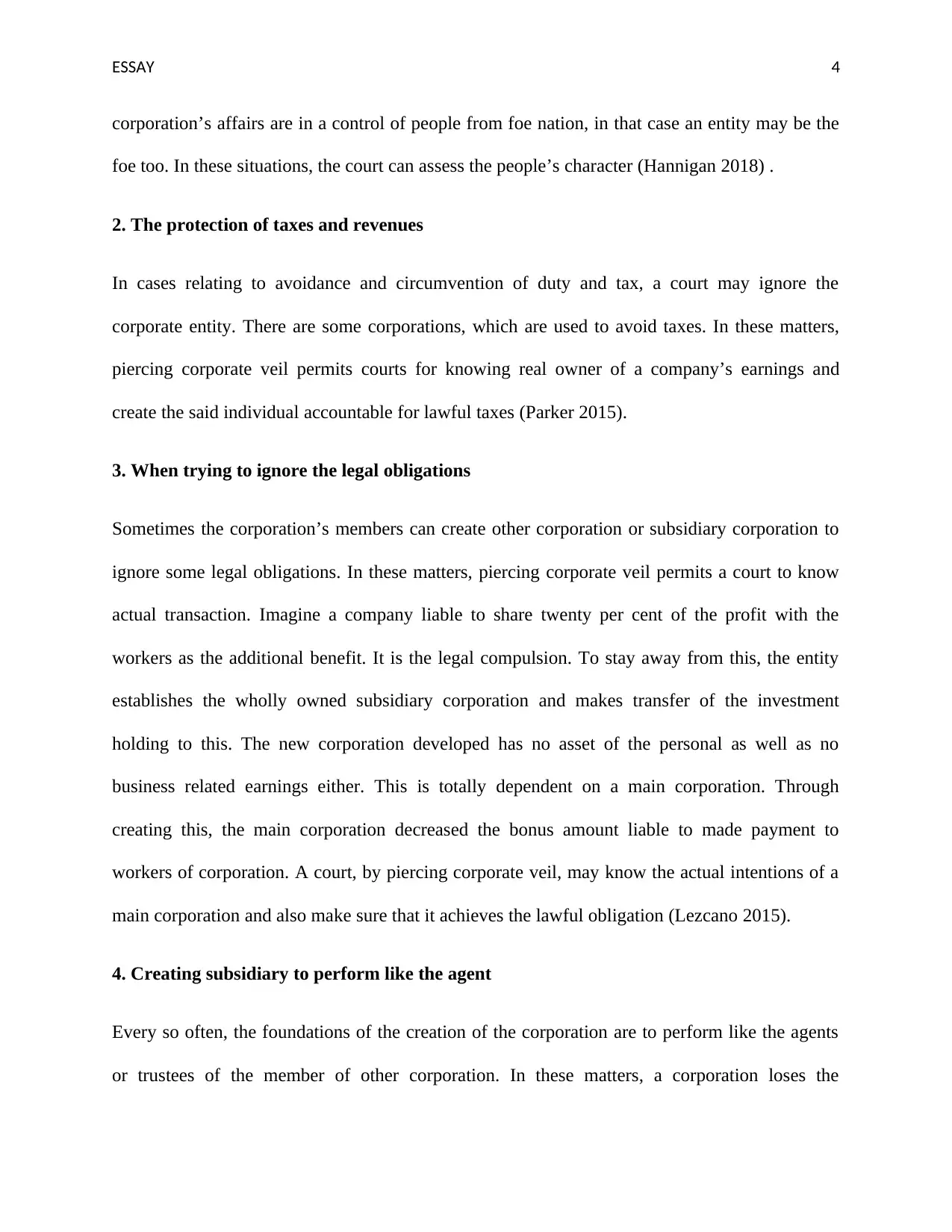
ESSAY 4
corporation’s affairs are in a control of people from foe nation, in that case an entity may be the
foe too. In these situations, the court can assess the people’s character (Hannigan 2018) .
2. The protection of taxes and revenues
In cases relating to avoidance and circumvention of duty and tax, a court may ignore the
corporate entity. There are some corporations, which are used to avoid taxes. In these matters,
piercing corporate veil permits courts for knowing real owner of a company’s earnings and
create the said individual accountable for lawful taxes (Parker 2015).
3. When trying to ignore the legal obligations
Sometimes the corporation’s members can create other corporation or subsidiary corporation to
ignore some legal obligations. In these matters, piercing corporate veil permits a court to know
actual transaction. Imagine a company liable to share twenty per cent of the profit with the
workers as the additional benefit. It is the legal compulsion. To stay away from this, the entity
establishes the wholly owned subsidiary corporation and makes transfer of the investment
holding to this. The new corporation developed has no asset of the personal as well as no
business related earnings either. This is totally dependent on a main corporation. Through
creating this, the main corporation decreased the bonus amount liable to made payment to
workers of corporation. A court, by piercing corporate veil, may know the actual intentions of a
main corporation and also make sure that it achieves the lawful obligation (Lezcano 2015).
4. Creating subsidiary to perform like the agent
Every so often, the foundations of the creation of the corporation are to perform like the agents
or trustees of the member of other corporation. In these matters, a corporation loses the
corporation’s affairs are in a control of people from foe nation, in that case an entity may be the
foe too. In these situations, the court can assess the people’s character (Hannigan 2018) .
2. The protection of taxes and revenues
In cases relating to avoidance and circumvention of duty and tax, a court may ignore the
corporate entity. There are some corporations, which are used to avoid taxes. In these matters,
piercing corporate veil permits courts for knowing real owner of a company’s earnings and
create the said individual accountable for lawful taxes (Parker 2015).
3. When trying to ignore the legal obligations
Sometimes the corporation’s members can create other corporation or subsidiary corporation to
ignore some legal obligations. In these matters, piercing corporate veil permits a court to know
actual transaction. Imagine a company liable to share twenty per cent of the profit with the
workers as the additional benefit. It is the legal compulsion. To stay away from this, the entity
establishes the wholly owned subsidiary corporation and makes transfer of the investment
holding to this. The new corporation developed has no asset of the personal as well as no
business related earnings either. This is totally dependent on a main corporation. Through
creating this, the main corporation decreased the bonus amount liable to made payment to
workers of corporation. A court, by piercing corporate veil, may know the actual intentions of a
main corporation and also make sure that it achieves the lawful obligation (Lezcano 2015).
4. Creating subsidiary to perform like the agent
Every so often, the foundations of the creation of the corporation are to perform like the agents
or trustees of the member of other corporation. In these matters, a corporation loses the
Paraphrase This Document
Need a fresh take? Get an instant paraphrase of this document with our AI Paraphraser
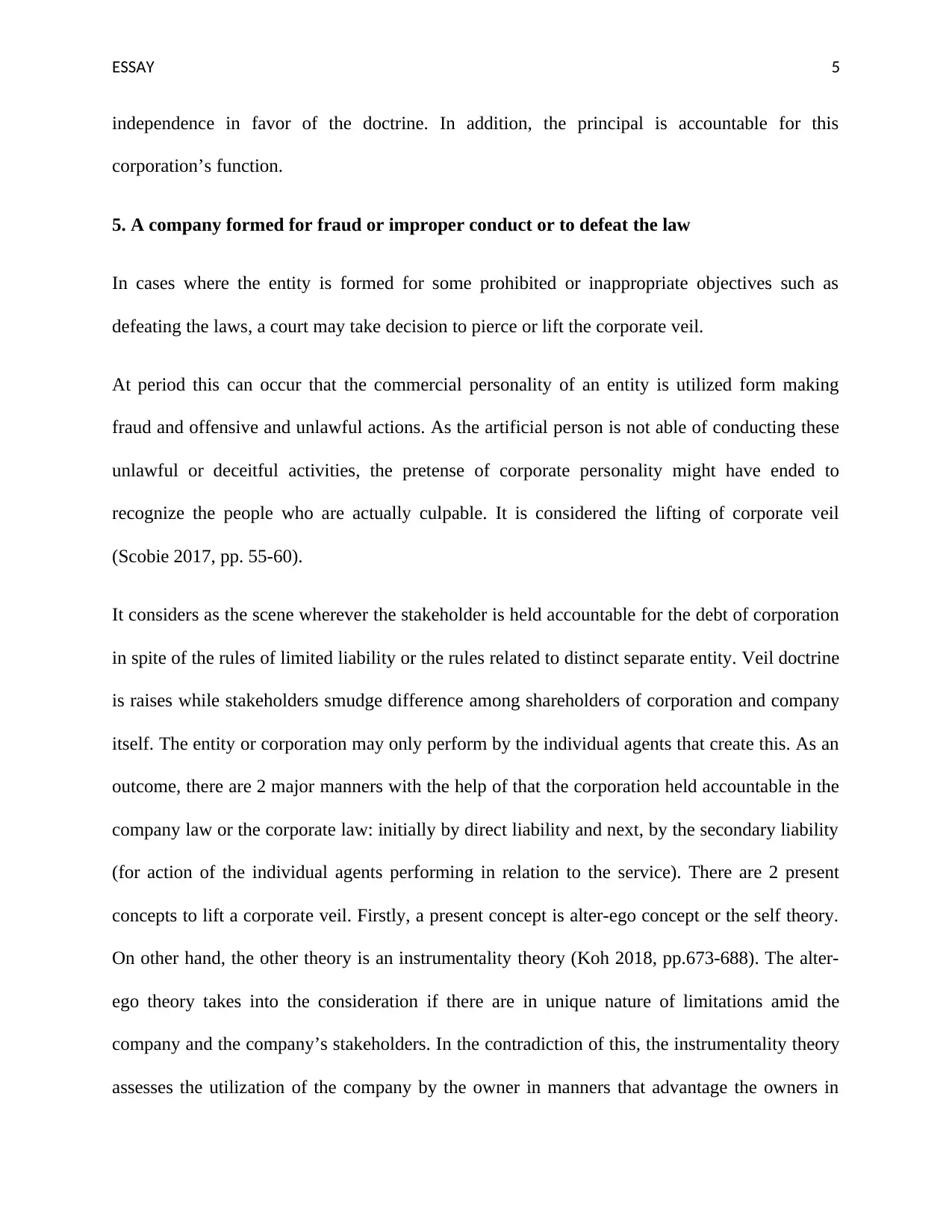
ESSAY 5
independence in favor of the doctrine. In addition, the principal is accountable for this
corporation’s function.
5. A company formed for fraud or improper conduct or to defeat the law
In cases where the entity is formed for some prohibited or inappropriate objectives such as
defeating the laws, a court may take decision to pierce or lift the corporate veil.
At period this can occur that the commercial personality of an entity is utilized form making
fraud and offensive and unlawful actions. As the artificial person is not able of conducting these
unlawful or deceitful activities, the pretense of corporate personality might have ended to
recognize the people who are actually culpable. It is considered the lifting of corporate veil
(Scobie 2017, pp. 55-60).
It considers as the scene wherever the stakeholder is held accountable for the debt of corporation
in spite of the rules of limited liability or the rules related to distinct separate entity. Veil doctrine
is raises while stakeholders smudge difference among shareholders of corporation and company
itself. The entity or corporation may only perform by the individual agents that create this. As an
outcome, there are 2 major manners with the help of that the corporation held accountable in the
company law or the corporate law: initially by direct liability and next, by the secondary liability
(for action of the individual agents performing in relation to the service). There are 2 present
concepts to lift a corporate veil. Firstly, a present concept is alter-ego concept or the self theory.
On other hand, the other theory is an instrumentality theory (Koh 2018, pp.673-688). The alter-
ego theory takes into the consideration if there are in unique nature of limitations amid the
company and the company’s stakeholders. In the contradiction of this, the instrumentality theory
assesses the utilization of the company by the owner in manners that advantage the owners in
independence in favor of the doctrine. In addition, the principal is accountable for this
corporation’s function.
5. A company formed for fraud or improper conduct or to defeat the law
In cases where the entity is formed for some prohibited or inappropriate objectives such as
defeating the laws, a court may take decision to pierce or lift the corporate veil.
At period this can occur that the commercial personality of an entity is utilized form making
fraud and offensive and unlawful actions. As the artificial person is not able of conducting these
unlawful or deceitful activities, the pretense of corporate personality might have ended to
recognize the people who are actually culpable. It is considered the lifting of corporate veil
(Scobie 2017, pp. 55-60).
It considers as the scene wherever the stakeholder is held accountable for the debt of corporation
in spite of the rules of limited liability or the rules related to distinct separate entity. Veil doctrine
is raises while stakeholders smudge difference among shareholders of corporation and company
itself. The entity or corporation may only perform by the individual agents that create this. As an
outcome, there are 2 major manners with the help of that the corporation held accountable in the
company law or the corporate law: initially by direct liability and next, by the secondary liability
(for action of the individual agents performing in relation to the service). There are 2 present
concepts to lift a corporate veil. Firstly, a present concept is alter-ego concept or the self theory.
On other hand, the other theory is an instrumentality theory (Koh 2018, pp.673-688). The alter-
ego theory takes into the consideration if there are in unique nature of limitations amid the
company and the company’s stakeholders. In the contradiction of this, the instrumentality theory
assesses the utilization of the company by the owner in manners that advantage the owners in
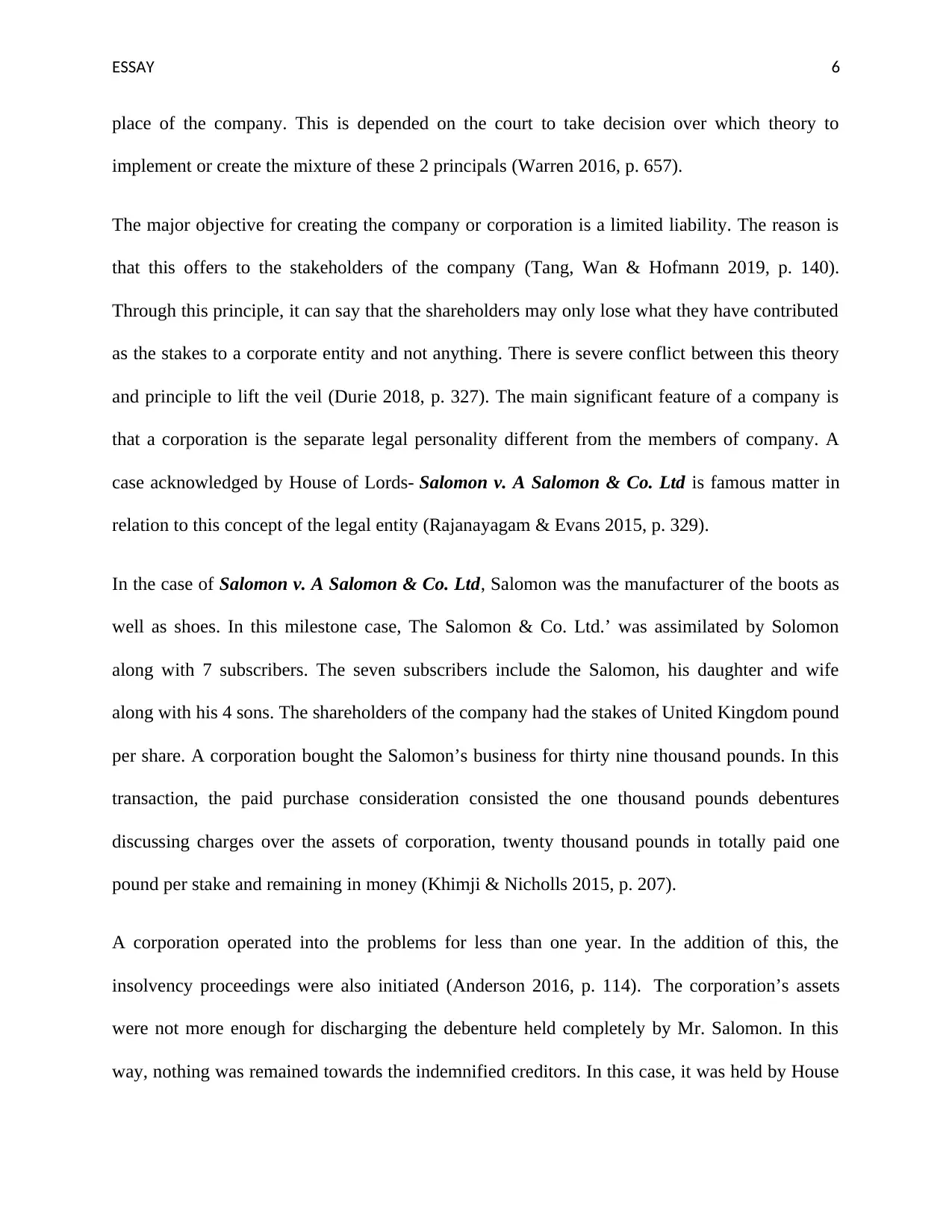
ESSAY 6
place of the company. This is depended on the court to take decision over which theory to
implement or create the mixture of these 2 principals (Warren 2016, p. 657).
The major objective for creating the company or corporation is a limited liability. The reason is
that this offers to the stakeholders of the company (Tang, Wan & Hofmann 2019, p. 140).
Through this principle, it can say that the shareholders may only lose what they have contributed
as the stakes to a corporate entity and not anything. There is severe conflict between this theory
and principle to lift the veil (Durie 2018, p. 327). The main significant feature of a company is
that a corporation is the separate legal personality different from the members of company. A
case acknowledged by House of Lords- Salomon v. A Salomon & Co. Ltd is famous matter in
relation to this concept of the legal entity (Rajanayagam & Evans 2015, p. 329).
In the case of Salomon v. A Salomon & Co. Ltd, Salomon was the manufacturer of the boots as
well as shoes. In this milestone case, The Salomon & Co. Ltd.’ was assimilated by Solomon
along with 7 subscribers. The seven subscribers include the Salomon, his daughter and wife
along with his 4 sons. The shareholders of the company had the stakes of United Kingdom pound
per share. A corporation bought the Salomon’s business for thirty nine thousand pounds. In this
transaction, the paid purchase consideration consisted the one thousand pounds debentures
discussing charges over the assets of corporation, twenty thousand pounds in totally paid one
pound per stake and remaining in money (Khimji & Nicholls 2015, p. 207).
A corporation operated into the problems for less than one year. In the addition of this, the
insolvency proceedings were also initiated (Anderson 2016, p. 114). The corporation’s assets
were not more enough for discharging the debenture held completely by Mr. Salomon. In this
way, nothing was remained towards the indemnified creditors. In this case, it was held by House
place of the company. This is depended on the court to take decision over which theory to
implement or create the mixture of these 2 principals (Warren 2016, p. 657).
The major objective for creating the company or corporation is a limited liability. The reason is
that this offers to the stakeholders of the company (Tang, Wan & Hofmann 2019, p. 140).
Through this principle, it can say that the shareholders may only lose what they have contributed
as the stakes to a corporate entity and not anything. There is severe conflict between this theory
and principle to lift the veil (Durie 2018, p. 327). The main significant feature of a company is
that a corporation is the separate legal personality different from the members of company. A
case acknowledged by House of Lords- Salomon v. A Salomon & Co. Ltd is famous matter in
relation to this concept of the legal entity (Rajanayagam & Evans 2015, p. 329).
In the case of Salomon v. A Salomon & Co. Ltd, Salomon was the manufacturer of the boots as
well as shoes. In this milestone case, The Salomon & Co. Ltd.’ was assimilated by Solomon
along with 7 subscribers. The seven subscribers include the Salomon, his daughter and wife
along with his 4 sons. The shareholders of the company had the stakes of United Kingdom pound
per share. A corporation bought the Salomon’s business for thirty nine thousand pounds. In this
transaction, the paid purchase consideration consisted the one thousand pounds debentures
discussing charges over the assets of corporation, twenty thousand pounds in totally paid one
pound per stake and remaining in money (Khimji & Nicholls 2015, p. 207).
A corporation operated into the problems for less than one year. In the addition of this, the
insolvency proceedings were also initiated (Anderson 2016, p. 114). The corporation’s assets
were not more enough for discharging the debenture held completely by Mr. Salomon. In this
way, nothing was remained towards the indemnified creditors. In this case, it was held by House
⊘ This is a preview!⊘
Do you want full access?
Subscribe today to unlock all pages.

Trusted by 1+ million students worldwide
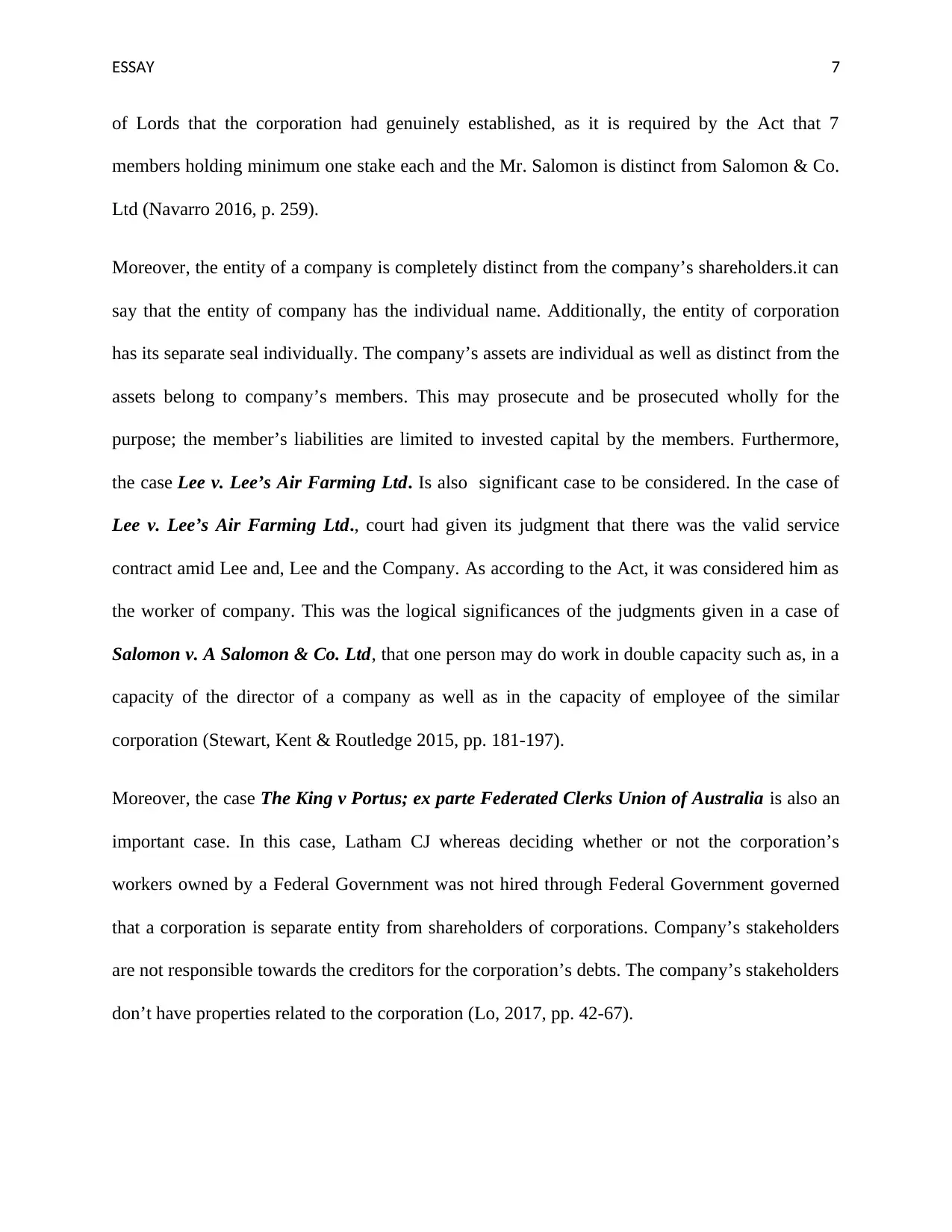
ESSAY 7
of Lords that the corporation had genuinely established, as it is required by the Act that 7
members holding minimum one stake each and the Mr. Salomon is distinct from Salomon & Co.
Ltd (Navarro 2016, p. 259).
Moreover, the entity of a company is completely distinct from the company’s shareholders.it can
say that the entity of company has the individual name. Additionally, the entity of corporation
has its separate seal individually. The company’s assets are individual as well as distinct from the
assets belong to company’s members. This may prosecute and be prosecuted wholly for the
purpose; the member’s liabilities are limited to invested capital by the members. Furthermore,
the case Lee v. Lee’s Air Farming Ltd. Is also significant case to be considered. In the case of
Lee v. Lee’s Air Farming Ltd., court had given its judgment that there was the valid service
contract amid Lee and, Lee and the Company. As according to the Act, it was considered him as
the worker of company. This was the logical significances of the judgments given in a case of
Salomon v. A Salomon & Co. Ltd, that one person may do work in double capacity such as, in a
capacity of the director of a company as well as in the capacity of employee of the similar
corporation (Stewart, Kent & Routledge 2015, pp. 181-197).
Moreover, the case The King v Portus; ex parte Federated Clerks Union of Australia is also an
important case. In this case, Latham CJ whereas deciding whether or not the corporation’s
workers owned by a Federal Government was not hired through Federal Government governed
that a corporation is separate entity from shareholders of corporations. Company’s stakeholders
are not responsible towards the creditors for the corporation’s debts. The company’s stakeholders
don’t have properties related to the corporation (Lo, 2017, pp. 42-67).
of Lords that the corporation had genuinely established, as it is required by the Act that 7
members holding minimum one stake each and the Mr. Salomon is distinct from Salomon & Co.
Ltd (Navarro 2016, p. 259).
Moreover, the entity of a company is completely distinct from the company’s shareholders.it can
say that the entity of company has the individual name. Additionally, the entity of corporation
has its separate seal individually. The company’s assets are individual as well as distinct from the
assets belong to company’s members. This may prosecute and be prosecuted wholly for the
purpose; the member’s liabilities are limited to invested capital by the members. Furthermore,
the case Lee v. Lee’s Air Farming Ltd. Is also significant case to be considered. In the case of
Lee v. Lee’s Air Farming Ltd., court had given its judgment that there was the valid service
contract amid Lee and, Lee and the Company. As according to the Act, it was considered him as
the worker of company. This was the logical significances of the judgments given in a case of
Salomon v. A Salomon & Co. Ltd, that one person may do work in double capacity such as, in a
capacity of the director of a company as well as in the capacity of employee of the similar
corporation (Stewart, Kent & Routledge 2015, pp. 181-197).
Moreover, the case The King v Portus; ex parte Federated Clerks Union of Australia is also an
important case. In this case, Latham CJ whereas deciding whether or not the corporation’s
workers owned by a Federal Government was not hired through Federal Government governed
that a corporation is separate entity from shareholders of corporations. Company’s stakeholders
are not responsible towards the creditors for the corporation’s debts. The company’s stakeholders
don’t have properties related to the corporation (Lo, 2017, pp. 42-67).
Paraphrase This Document
Need a fresh take? Get an instant paraphrase of this document with our AI Paraphraser
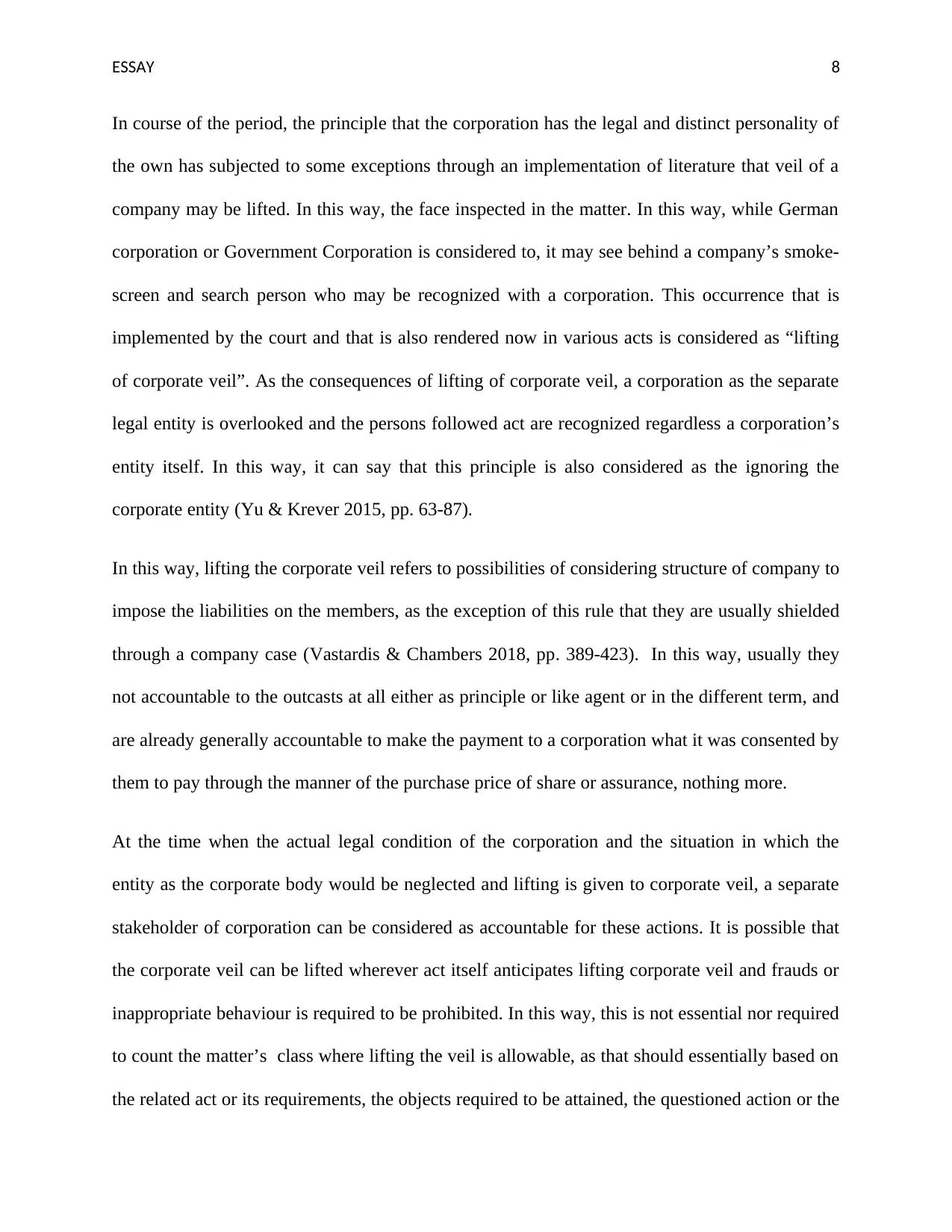
ESSAY 8
In course of the period, the principle that the corporation has the legal and distinct personality of
the own has subjected to some exceptions through an implementation of literature that veil of a
company may be lifted. In this way, the face inspected in the matter. In this way, while German
corporation or Government Corporation is considered to, it may see behind a company’s smoke-
screen and search person who may be recognized with a corporation. This occurrence that is
implemented by the court and that is also rendered now in various acts is considered as “lifting
of corporate veil”. As the consequences of lifting of corporate veil, a corporation as the separate
legal entity is overlooked and the persons followed act are recognized regardless a corporation’s
entity itself. In this way, it can say that this principle is also considered as the ignoring the
corporate entity (Yu & Krever 2015, pp. 63-87).
In this way, lifting the corporate veil refers to possibilities of considering structure of company to
impose the liabilities on the members, as the exception of this rule that they are usually shielded
through a company case (Vastardis & Chambers 2018, pp. 389-423). In this way, usually they
not accountable to the outcasts at all either as principle or like agent or in the different term, and
are already generally accountable to make the payment to a corporation what it was consented by
them to pay through the manner of the purchase price of share or assurance, nothing more.
At the time when the actual legal condition of the corporation and the situation in which the
entity as the corporate body would be neglected and lifting is given to corporate veil, a separate
stakeholder of corporation can be considered as accountable for these actions. It is possible that
the corporate veil can be lifted wherever act itself anticipates lifting corporate veil and frauds or
inappropriate behaviour is required to be prohibited. In this way, this is not essential nor required
to count the matter’s class where lifting the veil is allowable, as that should essentially based on
the related act or its requirements, the objects required to be attained, the questioned action or the
In course of the period, the principle that the corporation has the legal and distinct personality of
the own has subjected to some exceptions through an implementation of literature that veil of a
company may be lifted. In this way, the face inspected in the matter. In this way, while German
corporation or Government Corporation is considered to, it may see behind a company’s smoke-
screen and search person who may be recognized with a corporation. This occurrence that is
implemented by the court and that is also rendered now in various acts is considered as “lifting
of corporate veil”. As the consequences of lifting of corporate veil, a corporation as the separate
legal entity is overlooked and the persons followed act are recognized regardless a corporation’s
entity itself. In this way, it can say that this principle is also considered as the ignoring the
corporate entity (Yu & Krever 2015, pp. 63-87).
In this way, lifting the corporate veil refers to possibilities of considering structure of company to
impose the liabilities on the members, as the exception of this rule that they are usually shielded
through a company case (Vastardis & Chambers 2018, pp. 389-423). In this way, usually they
not accountable to the outcasts at all either as principle or like agent or in the different term, and
are already generally accountable to make the payment to a corporation what it was consented by
them to pay through the manner of the purchase price of share or assurance, nothing more.
At the time when the actual legal condition of the corporation and the situation in which the
entity as the corporate body would be neglected and lifting is given to corporate veil, a separate
stakeholder of corporation can be considered as accountable for these actions. It is possible that
the corporate veil can be lifted wherever act itself anticipates lifting corporate veil and frauds or
inappropriate behaviour is required to be prohibited. In this way, this is not essential nor required
to count the matter’s class where lifting the veil is allowable, as that should essentially based on
the related act or its requirements, the objects required to be attained, the questioned action or the
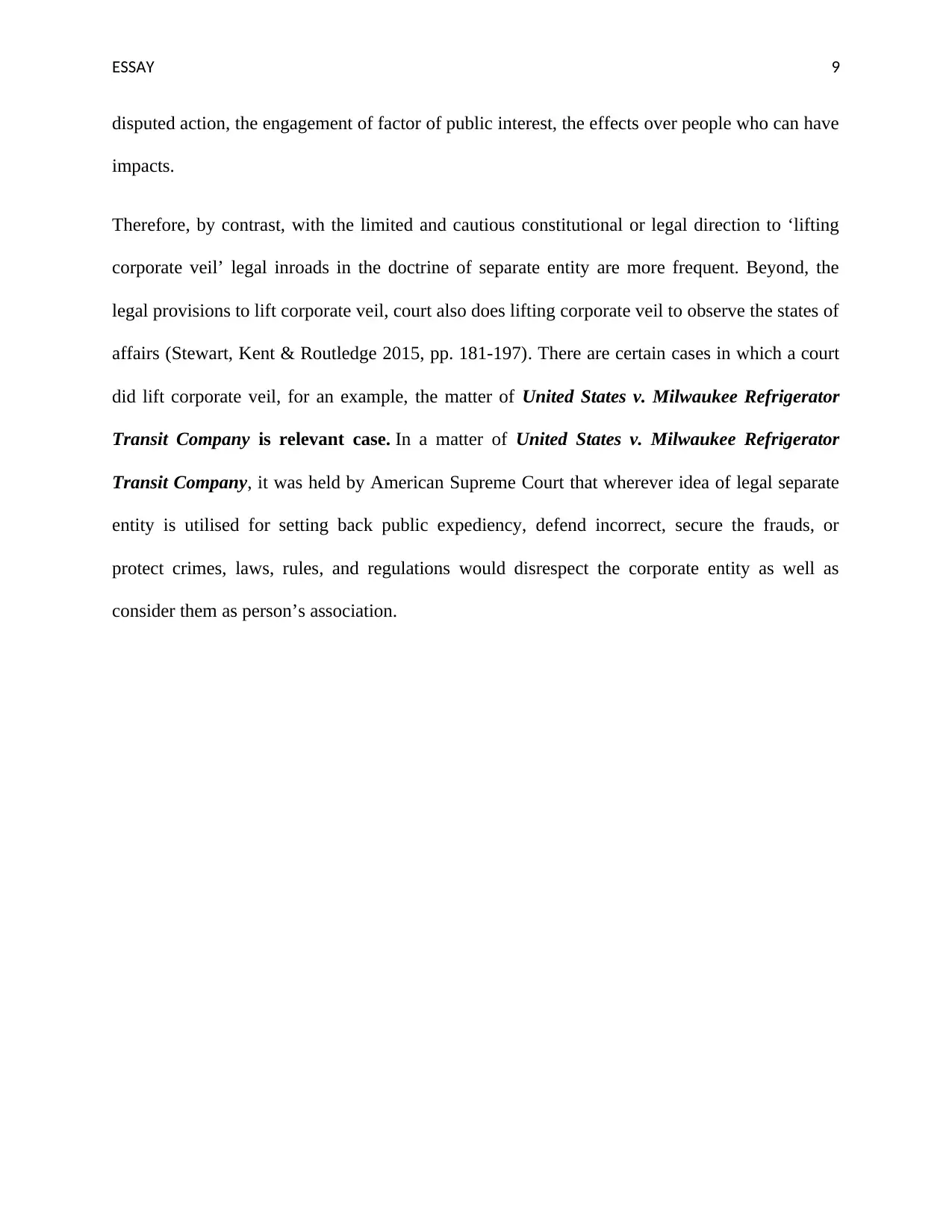
ESSAY 9
disputed action, the engagement of factor of public interest, the effects over people who can have
impacts.
Therefore, by contrast, with the limited and cautious constitutional or legal direction to ‘lifting
corporate veil’ legal inroads in the doctrine of separate entity are more frequent. Beyond, the
legal provisions to lift corporate veil, court also does lifting corporate veil to observe the states of
affairs (Stewart, Kent & Routledge 2015, pp. 181-197). There are certain cases in which a court
did lift corporate veil, for an example, the matter of United States v. Milwaukee Refrigerator
Transit Company is relevant case. In a matter of United States v. Milwaukee Refrigerator
Transit Company, it was held by American Supreme Court that wherever idea of legal separate
entity is utilised for setting back public expediency, defend incorrect, secure the frauds, or
protect crimes, laws, rules, and regulations would disrespect the corporate entity as well as
consider them as person’s association.
disputed action, the engagement of factor of public interest, the effects over people who can have
impacts.
Therefore, by contrast, with the limited and cautious constitutional or legal direction to ‘lifting
corporate veil’ legal inroads in the doctrine of separate entity are more frequent. Beyond, the
legal provisions to lift corporate veil, court also does lifting corporate veil to observe the states of
affairs (Stewart, Kent & Routledge 2015, pp. 181-197). There are certain cases in which a court
did lift corporate veil, for an example, the matter of United States v. Milwaukee Refrigerator
Transit Company is relevant case. In a matter of United States v. Milwaukee Refrigerator
Transit Company, it was held by American Supreme Court that wherever idea of legal separate
entity is utilised for setting back public expediency, defend incorrect, secure the frauds, or
protect crimes, laws, rules, and regulations would disrespect the corporate entity as well as
consider them as person’s association.
⊘ This is a preview!⊘
Do you want full access?
Subscribe today to unlock all pages.

Trusted by 1+ million students worldwide
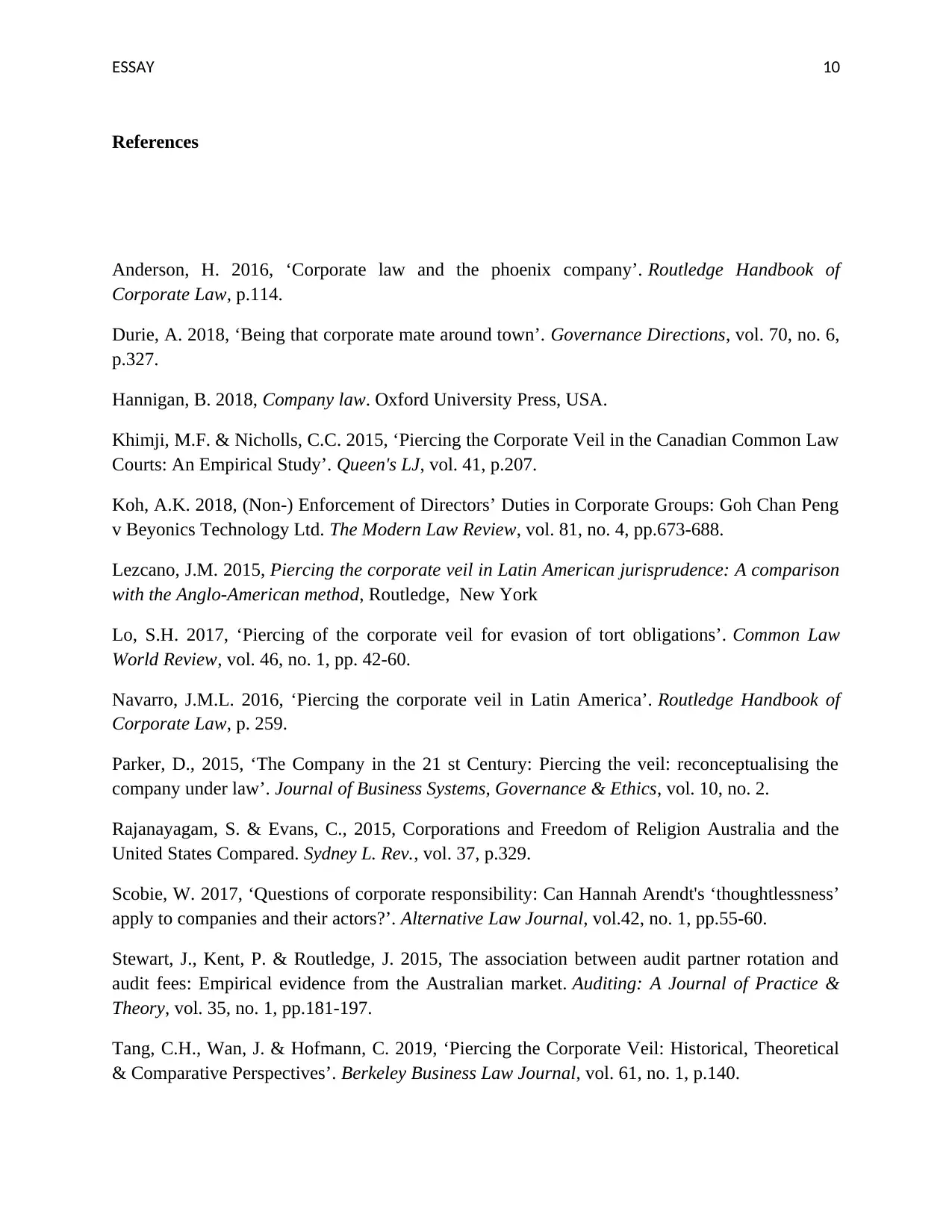
ESSAY 10
References
Anderson, H. 2016, ‘Corporate law and the phoenix company’. Routledge Handbook of
Corporate Law, p.114.
Durie, A. 2018, ‘Being that corporate mate around town’. Governance Directions, vol. 70, no. 6,
p.327.
Hannigan, B. 2018, Company law. Oxford University Press, USA.
Khimji, M.F. & Nicholls, C.C. 2015, ‘Piercing the Corporate Veil in the Canadian Common Law
Courts: An Empirical Study’. Queen's LJ, vol. 41, p.207.
Koh, A.K. 2018, (Non‐) Enforcement of Directors’ Duties in Corporate Groups: Goh Chan Peng
v Beyonics Technology Ltd. The Modern Law Review, vol. 81, no. 4, pp.673-688.
Lezcano, J.M. 2015, Piercing the corporate veil in Latin American jurisprudence: A comparison
with the Anglo-American method, Routledge, New York
Lo, S.H. 2017, ‘Piercing of the corporate veil for evasion of tort obligations’. Common Law
World Review, vol. 46, no. 1, pp. 42-60.
Navarro, J.M.L. 2016, ‘Piercing the corporate veil in Latin America’. Routledge Handbook of
Corporate Law, p. 259.
Parker, D., 2015, ‘The Company in the 21 st Century: Piercing the veil: reconceptualising the
company under law’. Journal of Business Systems, Governance & Ethics, vol. 10, no. 2.
Rajanayagam, S. & Evans, C., 2015, Corporations and Freedom of Religion Australia and the
United States Compared. Sydney L. Rev., vol. 37, p.329.
Scobie, W. 2017, ‘Questions of corporate responsibility: Can Hannah Arendt's ‘thoughtlessness’
apply to companies and their actors?’. Alternative Law Journal, vol.42, no. 1, pp.55-60.
Stewart, J., Kent, P. & Routledge, J. 2015, The association between audit partner rotation and
audit fees: Empirical evidence from the Australian market. Auditing: A Journal of Practice &
Theory, vol. 35, no. 1, pp.181-197.
Tang, C.H., Wan, J. & Hofmann, C. 2019, ‘Piercing the Corporate Veil: Historical, Theoretical
& Comparative Perspectives’. Berkeley Business Law Journal, vol. 61, no. 1, p.140.
References
Anderson, H. 2016, ‘Corporate law and the phoenix company’. Routledge Handbook of
Corporate Law, p.114.
Durie, A. 2018, ‘Being that corporate mate around town’. Governance Directions, vol. 70, no. 6,
p.327.
Hannigan, B. 2018, Company law. Oxford University Press, USA.
Khimji, M.F. & Nicholls, C.C. 2015, ‘Piercing the Corporate Veil in the Canadian Common Law
Courts: An Empirical Study’. Queen's LJ, vol. 41, p.207.
Koh, A.K. 2018, (Non‐) Enforcement of Directors’ Duties in Corporate Groups: Goh Chan Peng
v Beyonics Technology Ltd. The Modern Law Review, vol. 81, no. 4, pp.673-688.
Lezcano, J.M. 2015, Piercing the corporate veil in Latin American jurisprudence: A comparison
with the Anglo-American method, Routledge, New York
Lo, S.H. 2017, ‘Piercing of the corporate veil for evasion of tort obligations’. Common Law
World Review, vol. 46, no. 1, pp. 42-60.
Navarro, J.M.L. 2016, ‘Piercing the corporate veil in Latin America’. Routledge Handbook of
Corporate Law, p. 259.
Parker, D., 2015, ‘The Company in the 21 st Century: Piercing the veil: reconceptualising the
company under law’. Journal of Business Systems, Governance & Ethics, vol. 10, no. 2.
Rajanayagam, S. & Evans, C., 2015, Corporations and Freedom of Religion Australia and the
United States Compared. Sydney L. Rev., vol. 37, p.329.
Scobie, W. 2017, ‘Questions of corporate responsibility: Can Hannah Arendt's ‘thoughtlessness’
apply to companies and their actors?’. Alternative Law Journal, vol.42, no. 1, pp.55-60.
Stewart, J., Kent, P. & Routledge, J. 2015, The association between audit partner rotation and
audit fees: Empirical evidence from the Australian market. Auditing: A Journal of Practice &
Theory, vol. 35, no. 1, pp.181-197.
Tang, C.H., Wan, J. & Hofmann, C. 2019, ‘Piercing the Corporate Veil: Historical, Theoretical
& Comparative Perspectives’. Berkeley Business Law Journal, vol. 61, no. 1, p.140.
Paraphrase This Document
Need a fresh take? Get an instant paraphrase of this document with our AI Paraphraser
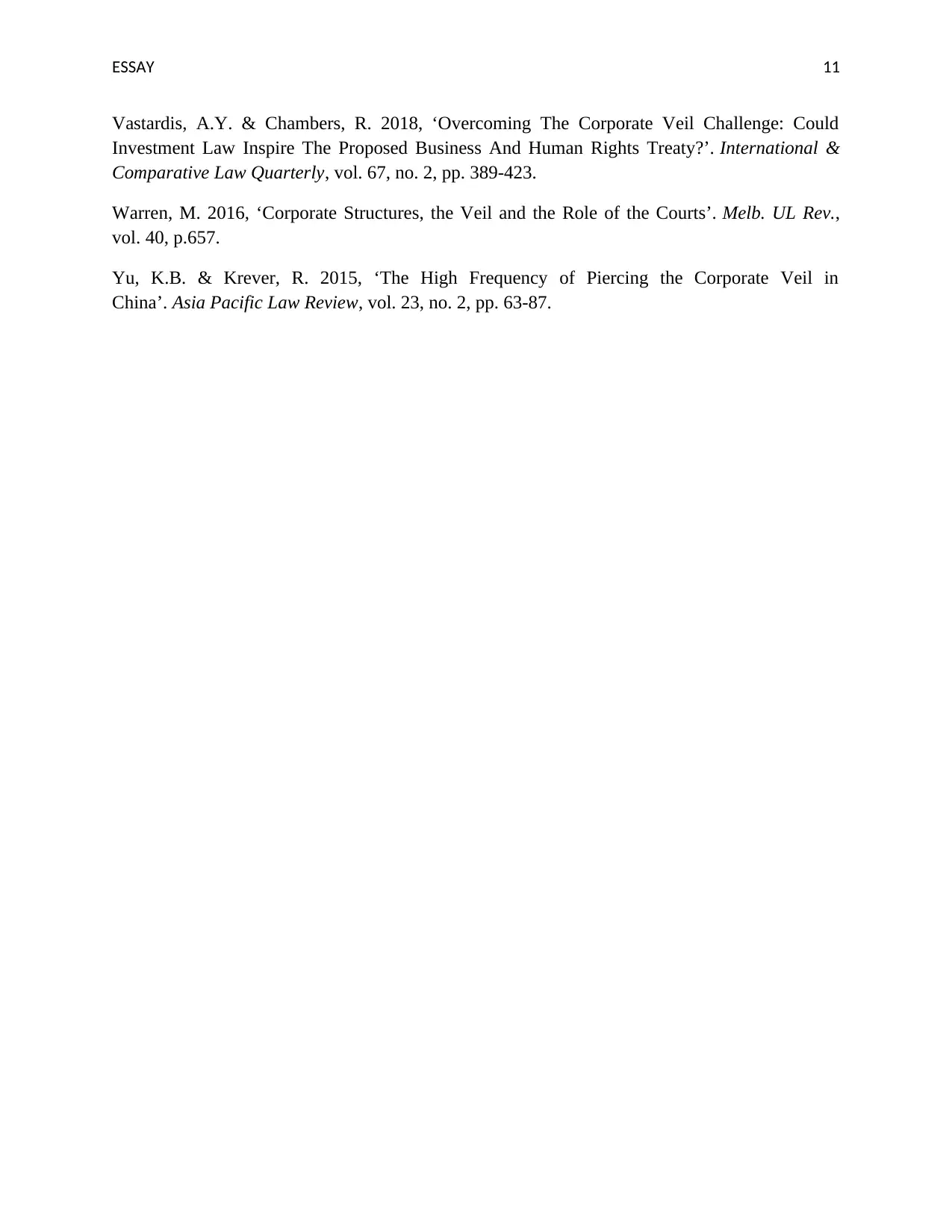
ESSAY 11
Vastardis, A.Y. & Chambers, R. 2018, ‘Overcoming The Corporate Veil Challenge: Could
Investment Law Inspire The Proposed Business And Human Rights Treaty?’. International &
Comparative Law Quarterly, vol. 67, no. 2, pp. 389-423.
Warren, M. 2016, ‘Corporate Structures, the Veil and the Role of the Courts’. Melb. UL Rev.,
vol. 40, p.657.
Yu, K.B. & Krever, R. 2015, ‘The High Frequency of Piercing the Corporate Veil in
China’. Asia Pacific Law Review, vol. 23, no. 2, pp. 63-87.
Vastardis, A.Y. & Chambers, R. 2018, ‘Overcoming The Corporate Veil Challenge: Could
Investment Law Inspire The Proposed Business And Human Rights Treaty?’. International &
Comparative Law Quarterly, vol. 67, no. 2, pp. 389-423.
Warren, M. 2016, ‘Corporate Structures, the Veil and the Role of the Courts’. Melb. UL Rev.,
vol. 40, p.657.
Yu, K.B. & Krever, R. 2015, ‘The High Frequency of Piercing the Corporate Veil in
China’. Asia Pacific Law Review, vol. 23, no. 2, pp. 63-87.
1 out of 11
Related Documents
Your All-in-One AI-Powered Toolkit for Academic Success.
+13062052269
info@desklib.com
Available 24*7 on WhatsApp / Email
![[object Object]](/_next/static/media/star-bottom.7253800d.svg)
Unlock your academic potential
Copyright © 2020–2025 A2Z Services. All Rights Reserved. Developed and managed by ZUCOL.





